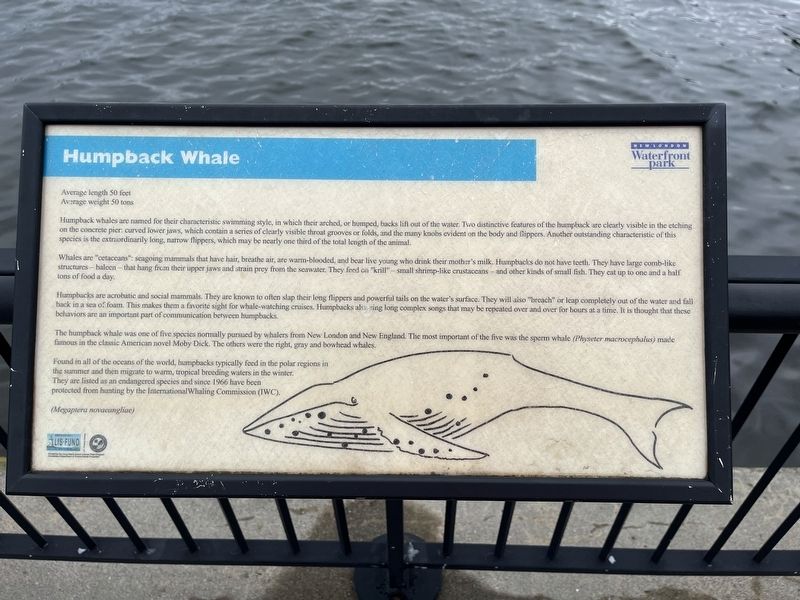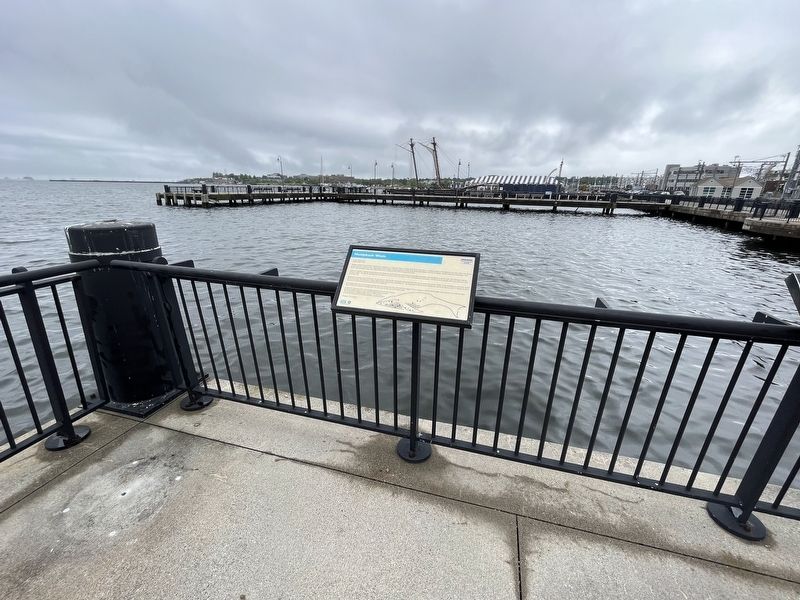New London in New London County, Connecticut — The American Northeast (New England)
Humpback Whale
New London Waterfront Park
Average length 50 feet
Average weight 50 tons
Humpback whales are named for their characteristic swimming style, in which their arched, or humped, backs lift out of the water. Two distinct features of the humpback are clearly visible in the etching on the concrete pier: curved lower jaws, which contain a series of clearly visible throat grooves or folds, and the many knobs evident on the body and flippers. Another outstanding characteristic of this species is the extraordinarily long, narrow flippers, which may be nearly one third of the total length of the animal.
Whales are "cetaceans": seagoing mammals that have hair, breathe air, are warm-blooded, bear live young who drink their mother's milk. Humpbacks do not have teeth. They have large comb-like structures — baleen — that hang from their upper jaws and strain prey from the seawater. They feed on "krill" — small shrimp-like crustaceans — and other kinds of small fish. They eat up to one and a half tons of food a day.
Humpbacks are acrobatic and social animals. They are known to slap their long flippers and powerful tails on the water's surface. They will also "breach" or completely leap out of the water and fall back in a sea of foam. This makes them a favorite for whale-watching cruises. Humpbacks also sing long complex songs that may be repeated over and over for hours at a time. It is thought that these behaviors are an important part of communication between humpbacks.
The humpback whale was one of five species normally pursued by whalers from New London and New England. The most important of the five was the sperm whale (Physeter macrocephalus) made famous in the classic American novel Moby Dick. The others were the right, gray and bowhead whales.
Found in all of the oceans of the world, humpbacks typically feed in the polar regions in the summer and then migrate to warm, tropical breeding waters in the winter. They are listed as an endangered species and since 1966 have been protected from hunting by the International Whaling Commission (IWC).
(Megaptera novaeangliae)
Erected by Long Island Sound License Plate Program; Connecticut Department of Environmental Protection.
Topics. This historical marker is listed in these topic lists: Animals • Arts, Letters, Music • Environment • Industry & Commerce • Waterways & Vessels. A significant historical year for this entry is 1966.
Location. 41° 21.146′ N, 72° 5.613′ W. Marker is in New London, Connecticut, in New London County. Marker is on Waterfront Park east of Ferry Loading Ramp. Touch for map. Marker is at or near this postal address: 20 Waterfront Park, New London CT 06320, United States of America. Touch for directions.
Other nearby markers. At least 8 other markers are within walking distance of this marker. Eastern Oyster / Summer Flounder (a few steps from this marker); Northern Quahog / Winter Flounder (a few steps from this marker); The Amistad (within shouting distance of this marker); New London Waterfront (within shouting distance of this marker); Middle Passage to New London (within shouting distance of this marker); New London and the Sea (within shouting distance of this marker); Whaling Days (within shouting distance of this marker); The Hotel Bristol (about 300 feet away, measured in a direct line). Touch for a list and map of all markers in New London.
Additional commentary.
1. About the marker
While not all signs describing sea life qualify for the database, this sign serves as a historical marker because it describes the history and impact of the whaling industry.
— Submitted June 30, 2023, by Devry Becker Jones of Washington, District of Columbia.
Credits. This page was last revised on June 30, 2023. It was originally submitted on June 30, 2023, by Devry Becker Jones of Washington, District of Columbia. This page has been viewed 52 times since then and 11 times this year. Photos: 1, 2. submitted on June 30, 2023, by Devry Becker Jones of Washington, District of Columbia.

